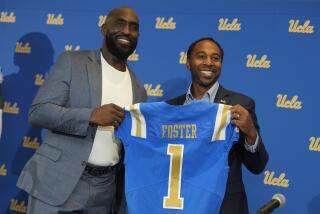Colleges Reap Rewards of Silicon Valley
- Share via
SAN JOSE — To high-flying venture capitalists in the Silicon Valley, donating money to their favorite university seems like a waste.
Why give $25,000 to stodgy endowment funds that earn 12%, when they know how to make it grow by five, 10 or 20 times in just a few years?
Now, seeking to accommodate donors who live and work in the high-tech world, UCLA has launched a venture capital fund here to benefit the university. The school plans to launch a second such fund in Los Angeles, where a growing number of UCLA alumni have gone into the venture capital business.
The move is part of a growing trend among universities. Stanford, the nursery to many high-tech ideas, pioneered the new approach to philanthropy. One of its funds has turned well-planted seed money into a $30-million harvest for its engineering school. Another has produced $11 million for its athletic department.
UC Berkeley also has a venture capital fund. Occidental College is putting one together.
“It’s a way to engage the imagination, if not the pocketbook, of the cyber-wealthy in California,” said David L. Lundberg, director of the new UCLA venture capital fund.
“The concept of venture capital takes on a different meaning up here,” Lundberg said while driving through the Silicon Valley. “People think it is a wild, speculative venture. But here, it’s considered a legitimate way to make money grow.”
A similar high-risk, high-return strategy is being embraced by academics on the other side of the Pacific Rim. Half a dozen Japanese universities have set up or plan to set up their own venture capital funds, according to a survey by the newspaper Nihon Keizai Shimbun.
Although universities are generally conservative with their money, many of them have long invested small portions of their endowments as venture capital. Given the success rate of blossoming Internet and biotech companies, universities are being seduced by the big score.
Williams College, for instance, had an extraordinary 27% growth in its endowment last year. The small liberal arts college in northwestern Massachusetts boasts that a quarter of its portfolio was in venture capital and other high-risk funds.
The University of California invested only 3.7% of its endowment and 2.2% of its pension funds as venture capital last year. But its treasurer wants to bet more. She notes that these small ventures have already added more than $1 billion to the university’s portfolio.
What’s new is how more and more universities are establishing separate funds to deal exclusively in venture capital--using their alumni networks and other connections to experts in the field.
Ron Conway, a founding general partner of Angel Investors in Atherton, Calif., had been involved in such a fund that raised $5 million for his oldest son’s Catholic high school.
When his son went off to UCLA, Conway figured that the university should join the gold rush. Lundberg jumped at the idea, and Conway held a fund-raising party for UCLA supporters at an event in his home honoring the 30th anniversary of the Internet.
“When [UCLA computer science professor] Leonard Kleinrock sent the first message to Stanford Research Institute, that was the birth of the Internet,” Conway said. “Most of the wealth has been made in the Silicon Valley. I think it’s appropriate for the Silicon Valley to set up a fund that benefits UCLA, where it all began.”
So far, the fund has raised more than $400,000 from donors who like to speculate. Conway and the board of 28 volunteer advisors have begun to sink the money into start-up companies. The group restricts each investment to $25,000, so it limits exposure and can easily slide into deals that often have too many investors clamoring for a piece of the action.
All proceeds will benefit UCLA’s College of Letters and Science.
Each investment is like a bet on the roulette table. The start-ups could easily founder. But Conway believes the odds are better than a spin of the wheel.
“If we’re lucky, we do what we normally do, we’ll get back five, 10 or 20 times the investment over a couple of years. We’re hoping that at least 90% of the companies are survivors and half of them produce pretty decent returns. If you hit on a huge one, you get 100 times your money back in one year.”
Such returns are as addictive as other forms of gambling. And so, the high-rolling philanthropy attracts a different kind of contributor.
“The people who have given us money said they wouldn’t have under other circumstances,” Lundberg said. “It’s a powerful tool of engaging people in their younger years. They give a little and help it grow.”
Theodore R. Mitchell, president of Occidental College in Eagle Rock, discovered the same attitude among alumni who have done well in the dot-com world.
“There’s a whole new generation of people who are thinking about philanthropy in a nontraditional way,” Mitchell said. He sees enormous potential for his small liberal arts college, which has faced financial turmoil in recent years.
“It’s a way,” he said, “to connect the college to the most powerful growth engine in the economy.”
Meanwhile, some of the pioneers at Stanford worry that so many universities are showing up that they’ll spoil the party.
“Ten years ago, Stanford was the only one doing it,” said Laura Breyfogle, a senior associate dean at Stanford’s engineering school. “Now the playing field is very crowded.”
Certainly the venture market is booming, she said.
But given how the strategy is catching on with universities, she said, “it’s harder to make money and harder to participate in deals.”






